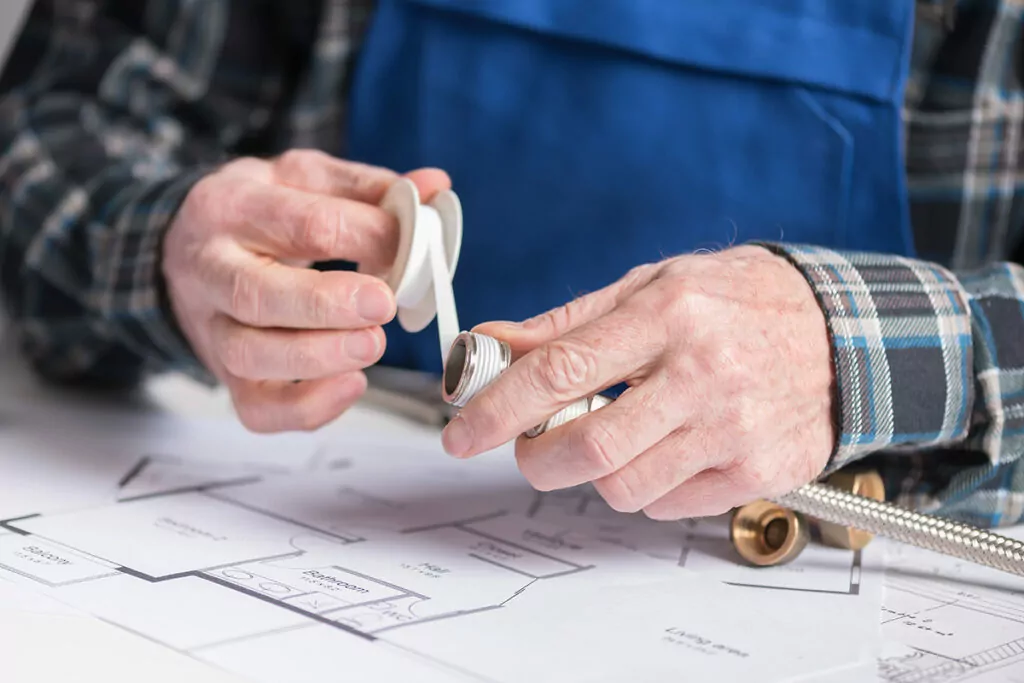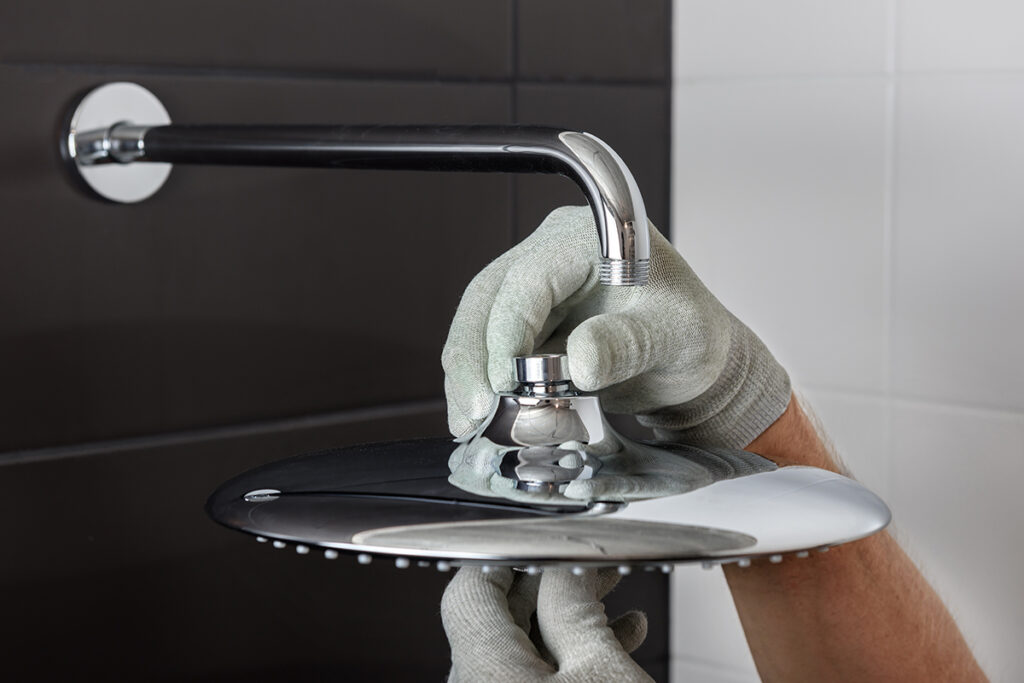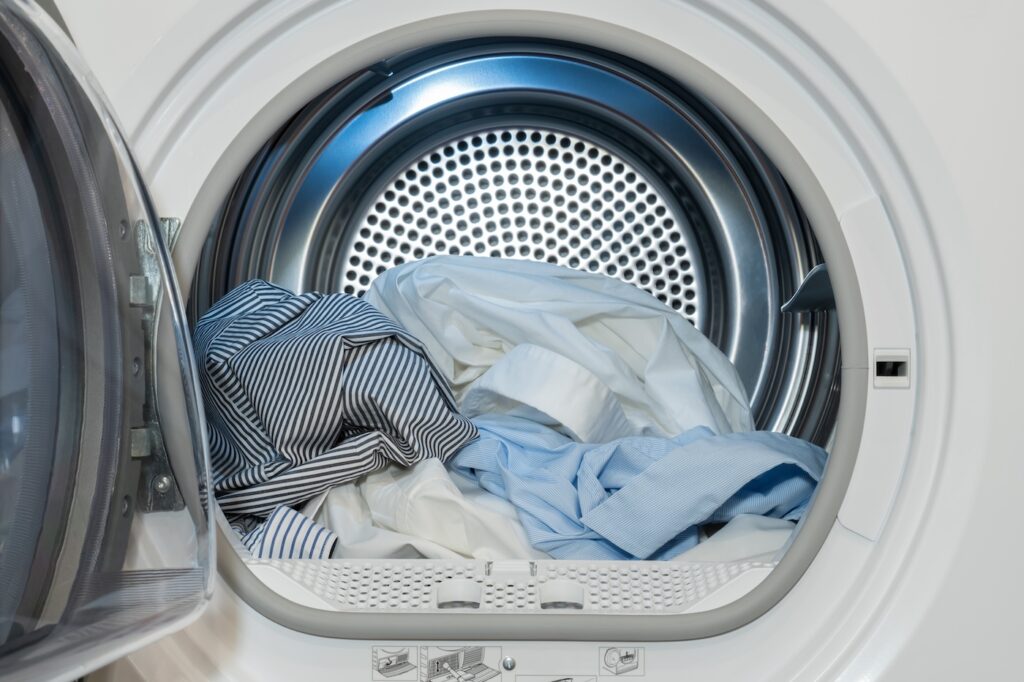When you’re not necessarily a “handy” person, you may not know how to install a shower head. Whether you’re upgrading your bathroom completely or simply needing to replace a shower head, it never hurts to learn the basics!
In this post, we’ll walk you through every step of the process and cover everything you need to know, including what tools are required, frequently asked questions, and step-by-step tips for installing and replacing a shower head. We’ll also explore when it’s best to tackle this task yourself and when it’s best to seek help. Let’s dive in!
Tools Needed to Change a Shower Head
There are a few key tools needed to change a shower head. Here’s a short list:
- New shower head
- New shower arm
- A properly fitting escutcheon (the small metal part that fits over the shower arm and against the wall)
- Teflon thread-sealing tape
- Flashlight
- Crescent wrench or channel lock pliers
- A rag or towel
Optional tools include:
- Liquid remover (for silicone)
- Utility razor
- A small brush (e.g., an old toothbrush)
If you have all these tools and materials, learning how to install a shower head will be easy!
How to Replace a Shower Head: 6 Steps
Now that you’re ready to learn how to replace a shower head, the great news is that it isn’t all that difficult! Below, we’ll go through all the steps necessary to replace your shower head and enjoy a new type of water flow in your bathroom.
1. Assess What Type of Shower Head You Want

There are a few different types of shower heads out there, including:
- Fixed shower heads. These screw directly into the shower arm pipe that fits through your wall.
- Handheld. These have a mount that holds a removable handheld spout. You can always replace a shower head with a handheld option.
- Combined fixed + handheld. These have a fixed head and a handheld spout, giving you the most flexibility. When you’re looking to replace a shower head with handheld pieces, however, there may be a few more steps to connect all the pieces.
- Rain shower head. These often fall from a horizontal spout directly above you and mimic the feel of rain. Consider hiring help if installing a shower head like this will require more in-depth plumbing work.
2. Make Sure the Water Faucet Is Off

Before you replace your shower head, make sure that your water supply is off. You can usually do this by closing the water valve located near the shower or in your home’s main water supply area.
3. Remove the Existing Shower Head

If you’re wondering how to remove an old shower head, rest assured that it’s actually quite simple. As a first step, secure a crescent wrench or channel-lock pliers around a rag or towel, which in turn should be wrapped around the shower head fitting. (This helps you avoid scratching the metal pieces.)
Gripping the tool around the rag, turn counter clockwise so the screw-on piece that fastens the shower head to the shower arm pipe loosens. Unscrew the shower head to remove it.
4. Clean the Shower Arm

Before you start your new shower head assembly, it’s often helpful to clean the pipe fitting on the shower arm with an old toothbrush. This can remove any buildup or old bits of pipe tape that could get in the way of securely screwing on a new shower head.
5. Wrap Teflon Thread-Sealing Tape Around the Threads

Once your shower arm fitting has been scrubbed clean of grime, wrap the threads with three loops of teflon thread sealing tape. If done properly, this will provide a tight and leak-proof connection when you screw on the new shower head.
6. Position the Replacement Shower Head

If you’re wondering “Is it easy to change a shower head?” this will be your moment of truth. For fixed shower heads, it’s usually quite simple! Just screw it on over the teflon thread sealing tape, and make sure the connection is snug. That’s it!
For handheld shower heads, screw the handheld shower mount onto the shower arm over the new layer of tape. Then connect the flexible hose to the mount and to the handheld spout. Adjust these steps as needed for combination shower heads, according to the manufacturer’s instructions!
7. Check for Leaks

Finally, turn on both the hot and cold water, and adjust the angle of your shower head as the water is coming out. If there are no leaks, you’re all set!
If you see a leak, however, it means the connection isn’t fully sealed. If your shower head came with a rubber washer, make sure that is in place. Otherwise, check to make sure the thread sealing tape is wrapped correctly around the shower arm connector.
Tips to Install a Shower Head
Shower head assembly isn’t usually that difficult, but there are some other things you may want to consider before attempting it.
- Always read the manufacturer’s guidelines before installing a shower head.
- Shower heads are usually standard in size, but double check any measurements before purchasing one for your particular space.
- Some shower arms come with rubber washers, which can remove the need for teflon tape.
- Keep the height and angle of your shower head in mind, and make sure the one you buy will actually work well in your space.
- Don’t ever be forceful with pipes when you untwist pieces or shift them, as this can cause thousands of dollars’ worth of pipe damage. If you need to adjust the placement of your pipe, try inserting a wrench end or screwdriver into it to provide more stability before trying to move it.

Replace Shower Head FAQs
Is it easy to change a shower head?
Yes. Replacing a shower head is a relatively easy DIY task—definitely easier than replacing a fan, sink, or vanity. It can be completed with basic tools and minimal knowledge.
How long do shower heads last?
The lifespan of a shower head can vary, but typically they will last 5-10 years. If your shower head develops buildup from water residue, soak it in something acidic (like vinegar) for an hour.
How to add a shower head to the bathtub?
To add a shower head to a bathtub, you’ll typically need a bathtub faucet with a diverter spout. When you pull the diverter, water will flow through the showerhead instead of the faucet.
Are shower heads universal?
No, shower heads come in various sizes and styles. It’s best to choose one that fits your existing shower arm and meets your needs, preferences, and space requirements. Knowing what type of shower head to buy is always your first step when learning how to install a shower head!
Not as handy as you’d like to be when it comes to upgrading your bathroom? Try hiring a Tasker to install your shower head today!














